The San Francisco Ballet comes to Lincoln Center with two mixed bills of ballets by seven choreographers.
The artistic director of a large ballet company must have headaches rather different from those of a Wall Street trader. His (and such directors tend to be male) “stocks” are highly volatile. Helgi Tomasson, who leads the San Francisco Ballet, can make predictions about how ballets by Christopher Wheeldon, Alexei Ratmansky, and Mark Morris will turn out (no worries with these three), but occasionally he has to take chances on relative newcomers (Edwaard Liang, for instance) to give the stockholders a little tang of newness, or perhaps venture outside his own comfort zone and secure an asset by, say, Wayne McGregor, who, as director of his own Wayne McGregor | Random Dance, has displayed approaches to the dancing body more akin to those of postmodernists.
Since 1985, when Tomasson took over SFB as artistic director, the company (founded in 1933 as part of the San Francisco Opera) has grown into an enterprise that boasts an international roster of dancers and an international reputation. He is also charged with maintaining good relations with his board of directors, making sure the company’s Balanchine ballets are in good order, and polishing up the annual Nutcracker. Above all, he has to keep in mind the company’s living, breathing capital: the dancers. Stocks being traded on the market do not get sick, injured, complain, or strain to become more valuable before the year is out. Headaches along the way (and maybe this very minute) are inevitable.
So far, during its current, very successful season (through October 27) at the former New York State Theater, SFB has presented two mixed bills, with Christopher Wheeldon’s (2012) Cinderella making its New York debut on October 23rd. The first program struck me as astutely planned—rather like an unconventional symphony with a classically assured and developed first movement (Tomasson’s Trio), a moody, mysterious second one (Wheeldon’s Ghosts©), and a volatile, kinky closer (McGregor’s Borderlands). And—what luck!—the first two were accompanied by the New York City Ballet orchestra, with SFB’s music director, Martin West, conducting.
Tomasson’s own Trio is set to Peter Ilyich Tchaikovsky’s String Sextet in D minor, Souvenir de Florence—a lovely piece. The choreographer has built his ballet expertly, often intriguingly, with an idea to introducing the classical chops of some of his principal dancers and the company’s high caliber ensemble. His musical sensibility, however, sometimes rubs me the wrong way. Vanessa Zahorian, who leads the robust first movement, may bend her uplifted leg in three delicate jerks to comply with the composer’s three note exclamation, but during many passages, the dancers’s phrases seem to ride the music companionably but not breathe with it.
The Kirov-trained Zahorian is a sleek, unmannered, quietly expressive dancer, with a fine way of suspending certain movements, and her partner, Vitor Luiz, supports her excellently and dances strongly and cleanly. Ten others, wearing plum-colored outfits by Mark Zappone, appear and disappear in trios, duets, and ensemble passages against a backdrop by Alexander V. Nichols that renders Florence as a brown maze of buildings in the manner of M.C. Escher.
There’s no ensemble for the second movement, which is abloom with sad, melodies that Tchaikovsky conjured up for the city he loved. The only dancers are Sarah Van Patten, Tiit Helimets, and Anthony Spaulding. This is a triangle without rivalry. Helimets who begins the ballet with Van Patten in his arms, seems resigned to having her rush to Spaulding every now and then. Perhaps Spaulding represents that lover who haunts Romanticism: Death. In any case, the men deal gently with the willowy, pliant Van Patten, who, in this ballet looks about 14 years old and delicate. Tchaikovsky’s third and fourth movements have a Slavonic air that suits the company’s two Russian principal dancers, Maria Kochetkova and Gennadi Nedvigin. They fly and spin and romp amid a supportive ensemble of ten.
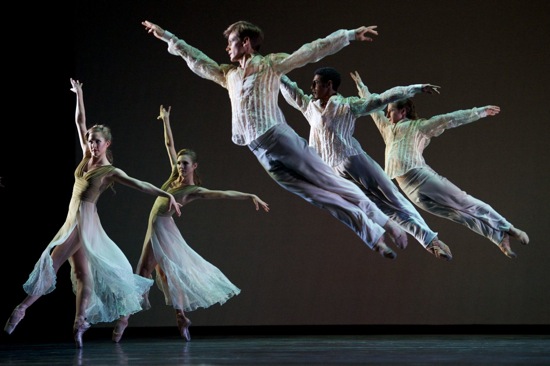
San Francisco Ballet dancers (L to R): Rebecca Rhodes, Alexandra Meyer-Lorey, Luke Willis, Francisco Mungamba, and Benjamin Stewart in Christopher Wheeldon’s Ghosts©. Photo: Erik Tomasson
I have no idea why the title of Wheeldon’s 2010 ballet for the company has to have a copyright symbol after it. Are those who present Ibsen’s play, Ghosts, given to lawsuits? That symbol is the only practical thing about Ghosts©, but not the most mysterious. The ballet is set to a haunting score of the same name by C.F. Kip Winger, the guitarist and leader of the rock band Winger, who has been branching out into orchestral compositions. Wheeldon is a wonderfully imaginative choreographer, adept at wedding offbeat ideas to rich movement that’s rife with dynamic and expressive nuances. The world he conjures up in Ghosts© seems to be a misty one, and Mary Louise Geiger’s projected moon helps conjure up light on water. The dancers’ gray clothes by Zappone are ghostly—with the women’s filmy skirts slit up one side and the men’s shirts transparent.
When the ballet begins, a number of the dancers are lying on the floor, while others stare upward. Men lay women out and walk away, then go back and help them up. In the many arresting patterns that Wheeldon designs for his principals, two groups of three, and an additional ensemble of six, people often sink to the floor, wilting when the music takes a dying fall. They seem to be in a kind of limbo between life and death, between swimming and drowning. Perhaps their lives are passing before their eyes. Sofiane Sylve dances with Helimets and Shane Wuerther. Damian Smith has Yuan Yuan Tan all to himself. Both women are eloquent, and the men devote themselves to the welfare of their beautiful partners. The ballet ends on a gasp; the clustered dancers, spinning, suddenly stop and thrust their arms up and out; it’s as if a giant flower has opened to the sun. Or the living have welcomed the inevitable.
Borderlands isn’t the first work by Wayne McGregor that SFB has presented, but it’s the first made expressly for them. And audiences in New York, like those in San Francisco, get a jolt out of seeing performers who can appear as exemplary classical dancers become suddenly boneless.
Can Kochetkova shoot one leg up to point at high noon? That’s nothing for her; she hits 1 P.M. The 2005 AtaXia revealed McGregor’s interest in people with neurological difficulties, and that interest has carried over into some of his other works. Such as Borderlands. In this piece, the dancers employ their marvelous physical intelligence as if movement were snaking along neural pathways and suddenly shifting to other tracks—often without loss of flow, sometimes jerky. Their hips jut out and swing; their limbs knot; their shoulders, elbows, head, and chest indulge in separate, simultaneous conversations. A wordless cocktail party taking place in a single body.
One of McGregor’s inspirations for Borderlands was the work of Johann Albers, especially that artist’s squares within squares, in which separate colors may vibrate together, fooling our perception. He has mentioned the dance as something that “pixillates the space,” and he and Lucy Carter have captured Albers’s ideas in a largely blue backdrop and in Carter’s changeable lighting; Curiously, he has dressed the dancers in functional gray shorts and jersey tops, keeping their legs bare (only occasionally do the women wear pointe shoes).
The twelve dancers combine and recombine—sometimes in intimate ways, with a kind of unacknowledged sensuality and a driving energy that matches Joel Cadbury and Paul Stoney’s score, in which piano melodies and other sweet and luminous sounds contrast to more dissonant crashing ones. As the backdrop slowly rises and alters, McGregor’s choreography does indeed pixillate the space in ways that make the pulse beat faster. It’s not wise to allow yourself, even for a moment, to think that the terrific dancers look like people with serious physical problems.
There’s no scenario here—only fervent designs being made and unmade. Kotchetkova creates unimaginable contortions with the aid of Lonnie Weeks in a pas de deux gone crazy. Frances Chung, Van Patten, Pascal Molat, and Carlos Quenedit tie and untie slipknots, as a foursome and in separate duets. They—along with Jamie Garcia Castilla, Koto Ishigara, Francisco Mungamba, Elizabeth Powell, Spaulding, and Sylve—dance like athletes practicing an as-yet-unknown sport, maybe with high fevers.
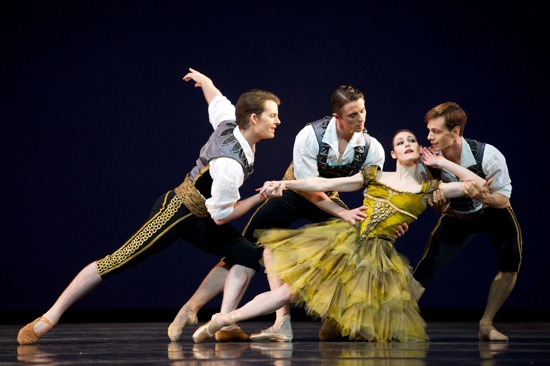
San Francisco Ballet dancers (L to R) Shane Wuerther, Luke Ingham, and Luke Willis court Sofiane Sylve in Alexei Ratmansky’s From Foreign Lands. Photo: Erik Tomasson
SFB’s second program at Lincoln Center is not quite so happily structured. It begins with two of its most arresting works but then goes on for what seems like a very long time. Alexei Ratmansky set his From Foreign Lands to Moritz Moszkowski’s eponymous Suite for Orchestra, Op. 23, and he follows the composer’s fairly subtle allusions to various European cultures. All twelve dancers appear more than once—changing their outfits to appear Russian, Italian, German, Spanish, Polish, and Hungarian. Colleen Atwood’s costumes are as clever as the choreography. Depending on the nationality, the women’s fluffy, ruffly skirts may be lavender, red, gold, brown (I may be forgetting some), and the men’s vests or jackets change accordingly. This makes Europe seem a very neighborly place.
As always, Ratmansky’s gift for beautiful, fluent, musical choreography is enhanced by his warm view of human relations. In the Russian sequence when Davit Karapetyan and Nedvigin lift their partners to fly above them for a few seconds, Zahorian and Chung reach down to take the men’s faces briefly between their hands. Molat is clearly delighted to have three women (Dores André, Dana Genshaft, and Van Patten) to dance with and for, and at the hint of a tarantella, these “Italians” turn and clap their hands in a way that evokes Bournonville’s Napoli (and reminds one that Ratmansky once danced in the Royal Danish Ballet).
Sylve, too, has as many partners as a person could handle, and what’s nice about the German section, with its sweet music, is that Luke Ingham, Luke Willis, and Wuerther show no rivalry, only their pleasure at being around such a charming woman. As for Sylve, she loves them all.
When the composer bursts into his zesty Spanish music, Chung, Molat, Van Patten, and Nedvigin (now all wearing red) match its ebullient temperament. All the remaining dancers then reappear and toss out a few mazurka steps to remind us that they’re next now Polish, and, shortly, everybody’s onstage being Hungarian. In Ratmanskyland, the Carpathian mountains are an easy border to cross. This choreographer tells us that a dance is a microcosm of a society, in which people watch one another and, usually, feel friendly. Dancers don’t simply exit the stage; they have someplace to go.
Morris, too, tends to make a cast into a clan, and who better than he to choreograph a dance for an all-male cast? I can think of no other choreographer who so nonchalantly or wittily or tenderly plays with traditional gender roles. The nine men (a mixture of principal dancers, soloists, and corps de ballet members) in Beaux hold hands and form chains, support one another, and join to create designs that suggest comradeship and shared purpose. Isaac Mizrahi has costumed the performers in unitards with a kind of festive camouflage patterning in red, orange, pink, and maroon, which mimics the backdrop (Mizrahi’s scenic element must be a projection, because its palette can change to blues and green).
The dancers show us all that men can be in terms of strength, playfulness, diligence, cleverness, and mischievousness. Their relationships are affectionate, but sexual attraction doesn’t really figure. Above all they collaborate in convivial, intriguing dance patterns. They take to the air—skip, leap, and so on—but not in displays of conventional virtuosity. And, as expected, Morris’s use of repetition binds the men together and formalizes the feelings that the choreography evokes. Several times, you watch how the first man in a hands-holding chain of three runs in a tight circle around the other two, until he has wrapped them in a girdle of arms; then you watch one of these embraces both wind and slowly unwind. Beaux, these men are—not in the sense of suitors, but as beautiful guys.
Morris’s musicality, as usual, mates what we see intimately with what we hear—in this case, Bohuslav Martinů’s Concerto for Harpsichord and Small Orchestra, and his Two Pieces for Harpsichord, No. 1. The rich, jangly sounds of the harpsichord (finely played by Bradley Moore) underscore the innate elegance as well as the robustness of Beaux.
Two major pieces of music accompany the two remaining dances on the SFB’s second program: Sergei Prokofiev’s Symphony No. 1 in D major, Op. 25 and Sergei Rachmaninov’s Symphonic Dances, Op. 45. They’re enough to daunt any dancemaker. Classical Symphony, by SFB’s resident choreographer, Yuri Possokhov, is an estimable ballet—well constructed and traditional, but with imaginative quirks. The choreography deploys a principal couple (Kochetkova and Hansuke Yamamoto), two demi-soloist pairs, and a corps of eight, in golden light by David Finn. Here Kochetkova, wearing one of Sandra Woodall’s ingenious wired gold tutus, displays her incredible flexibility within the ballerina code but lets her adroit partner spin her into a squat before he pulls her upright and kneels in homage. And, yes, there are flying leaps and fouettés, and Possokhov employs them tastefully.
It would be presumptuous of me to say that Edwaard Liang is in over his head with Symphonic Dances, since he has been developing as a choreographer for about ten years and has just become the artistic director of BalletMet Columbus, but Rachmaninov provides a challengingly turbulent lake of music, for all its danceable qualities. From the opening moments, when nine bronze-clad men and women stand in a line stretching away from the audience and break in and out of it in attractive ways, Liang creates a plethora of pleasing pictures and tricky steps. He’s so smart and so facile that he gives the impression of not stopping to question whether this move isn’t a little too weird or too arbitrary in a given context or to wonder whether a quiet moment might be in order.
A duet for Tan and Ingham calls to mind those old-time “adagio” acts, in which a ballroom dance duo engaged in lyrical acrobatics. What can Ingham not do with the gorgeous Tan of the sinuous arms and mile-high extensions? Can he leave her standing on her own two feet for a while? Apparently not. Duets for Sylve and Helimets, Kochetkova and Luiz are also, in their own ways, extravagant. Certainly there are satisfying moments. Liang also creates a spirited dance for the demi-soloists Sasha De Sola, Dana Genshaft, James Sofranco, and Daniel Deivison and a fine one for six men—athletes who show off their jumps and turns and slides in canon.
Symphonic Dances pleases the audience mightily, although it’s long, and an over-rich dessert to this feast of ballets. If you are delighted and excited by these dancers, you may want to see them all you can, but the better the choreography, the brighter they shine.

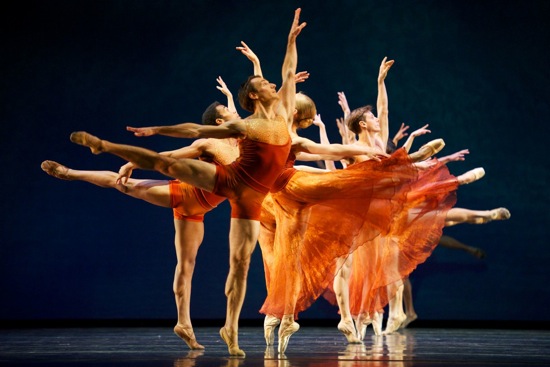
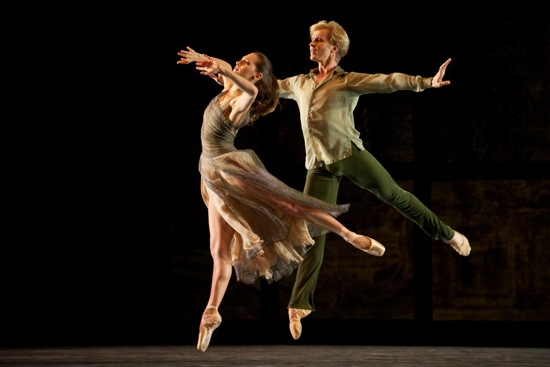
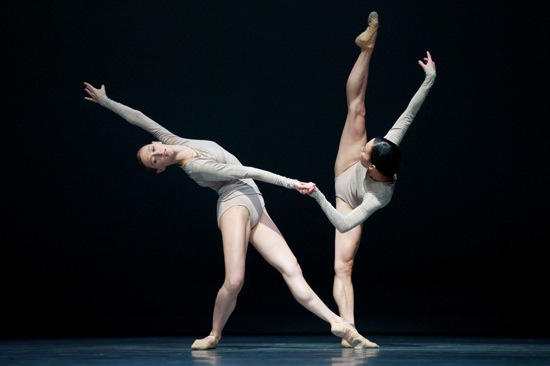
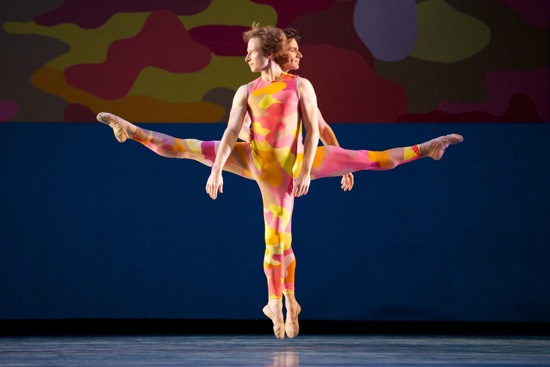
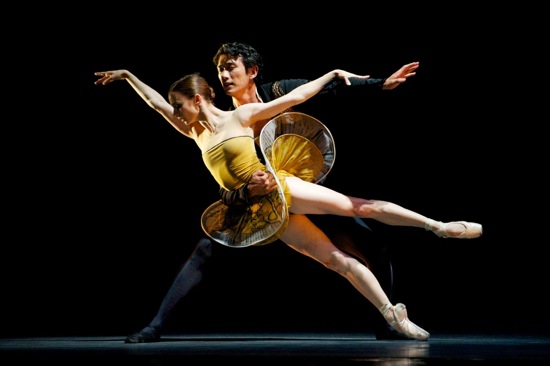
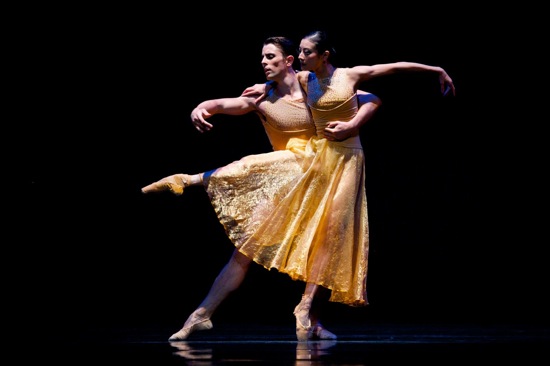
I Think this is Maria Kochetkova in The last photo…
I am grateful for Stina’s correction. I mixed up two photos and, obviously, didn’t look closely. The photo in question now fits the label. I changed the photo for one of Yuan Yuan Tan and Luke Ingham, rather than correcting the caption, since Kochetkova is already pictured in my post, and it’s nice to have an image of another fine SFB dancer.
Thank you for your intelligent and quite thorough critique of our favorite Left Coast company. As a dance writer, I greatly enjoy your always-evocative descriptions; I know from your reviews of works I *have* seen that your skill must also aptly conjure the works I *haven’t* seen. In this case, having seen every SFB ballet being presented in NY during this tour, I can definitely commend you for the accuracies in your review.
There *is* a way to publicly acknowledge/appreciate the mega-talented (and beloved) SFB artists, even when the choreography isn’t one’s cup of tea, or doesn’t hold up to a choreographer’s other ballets, and you use finesse and delicacy, which is refreshing and welcome, in comparison to some of the other NY dance writers, who seem overly fond of choreographer-bashing, while ignoring the supremely skilled dancers.
Keeping in mind that SFB is known for having the most (arguably) versatile dancers in the country, choreographers *do* flock to SFB loaded with new ideas every single year. Not all of them are going to be each choreographer’s “best” work to date, but one can always count on the excitement of having something new unfold before our eyes.
And in every single new work, be it great, good or not so much, the dancers give it their all. They are steadfastly and consistently chosen for all these new ballets, because they are, quite simply, the best in the biz, when it comes to being *adaptable*, while being technically skilled, unparalleled in speed and attack, and still rich in dramatic depth, for the works that call for that.
Thank you for presenting an informed and unbiased review of the world-renown SFB dancers that represent every choreographers’ dream team.
Thanks, Deborah, for your insightful coverage of the SFB performances. I saw some of these ballets in London last fall, and Morris’s Beaux struck me as charming, if a bit slight. Mizrahi’s pink/orange/yellow camo decor and costumes are terrifically clever–because of the colors, patterns meant to hide the body instead display it vividly, an analog to the idea that male dancers today no longer need to hide their identity or their sexuality because of stereotypical associations with their profession. This makes it a perfect ballet for SF. Yet as you say, the choreography isn’t in the least homoerotic, and when a larger man lifts a smaller, and then the smaller returns the favor, we get one of Morris’s endlessly fascinating string of lessons in the physics of the body. Near the end, if I remember right, the nine dancers form two squares, with one performer in the middle–a kind of simplified homage to the opening of Serenade, as if to say, “Guys can do this beautifully, too.”
When I covered SFB’s London performances, the Liang piece disheartened me too much to write about it (it was an omnibus review that also included Royal Ballet and Birmingham Royal performances). The work struck me as a structural jumble with some expressive romantic moments broken by over-ingenious partnering and other stylistic tics. But like you, I also found the Possokhov to Prokofiev ingratiating, a strong piece for this strong company.
I’m very glad to see you refer to the venue where NYCB perform as “the former New York State Theater.” I likewise try to resist using its current name, calling it either that or “their Lincoln Center home.” Thank you, and thank you for the review.
look like in the fairy tales, modern and classical